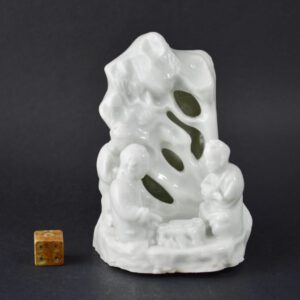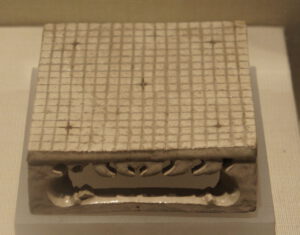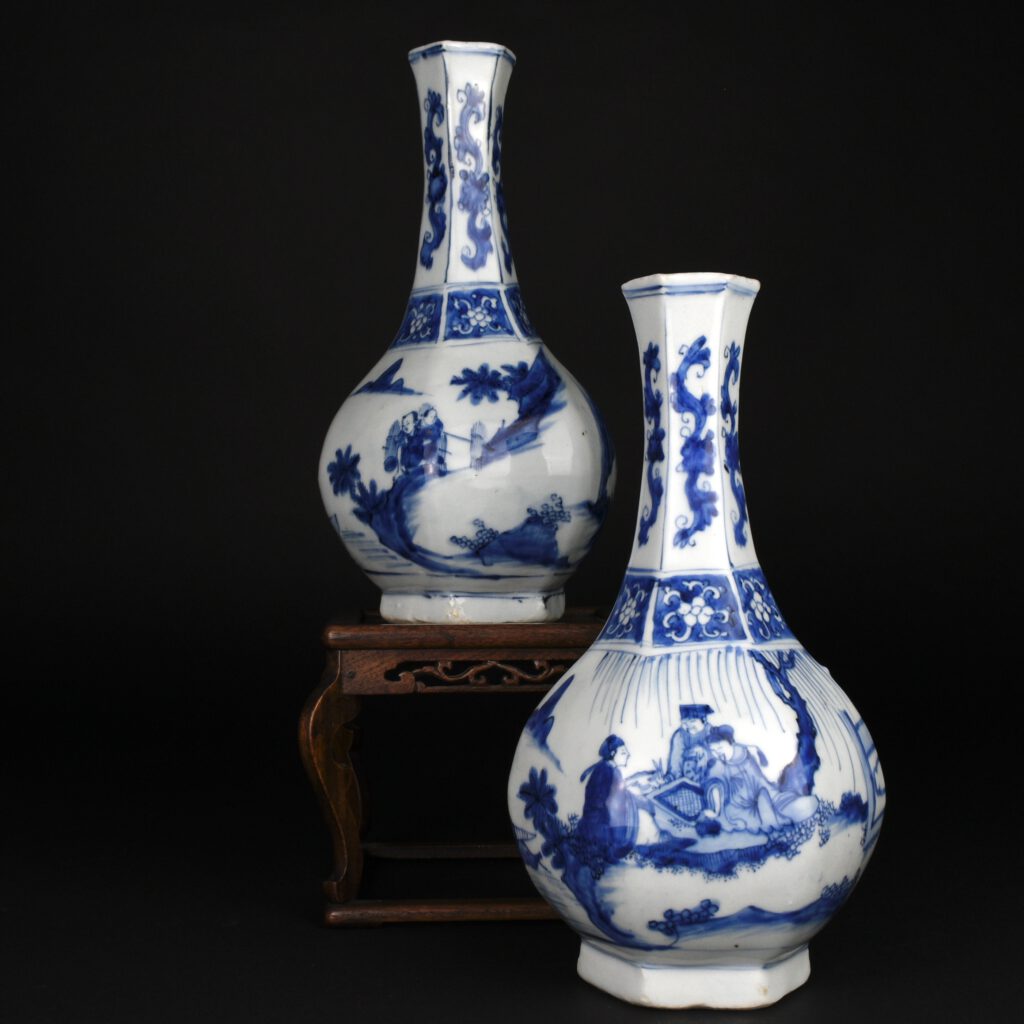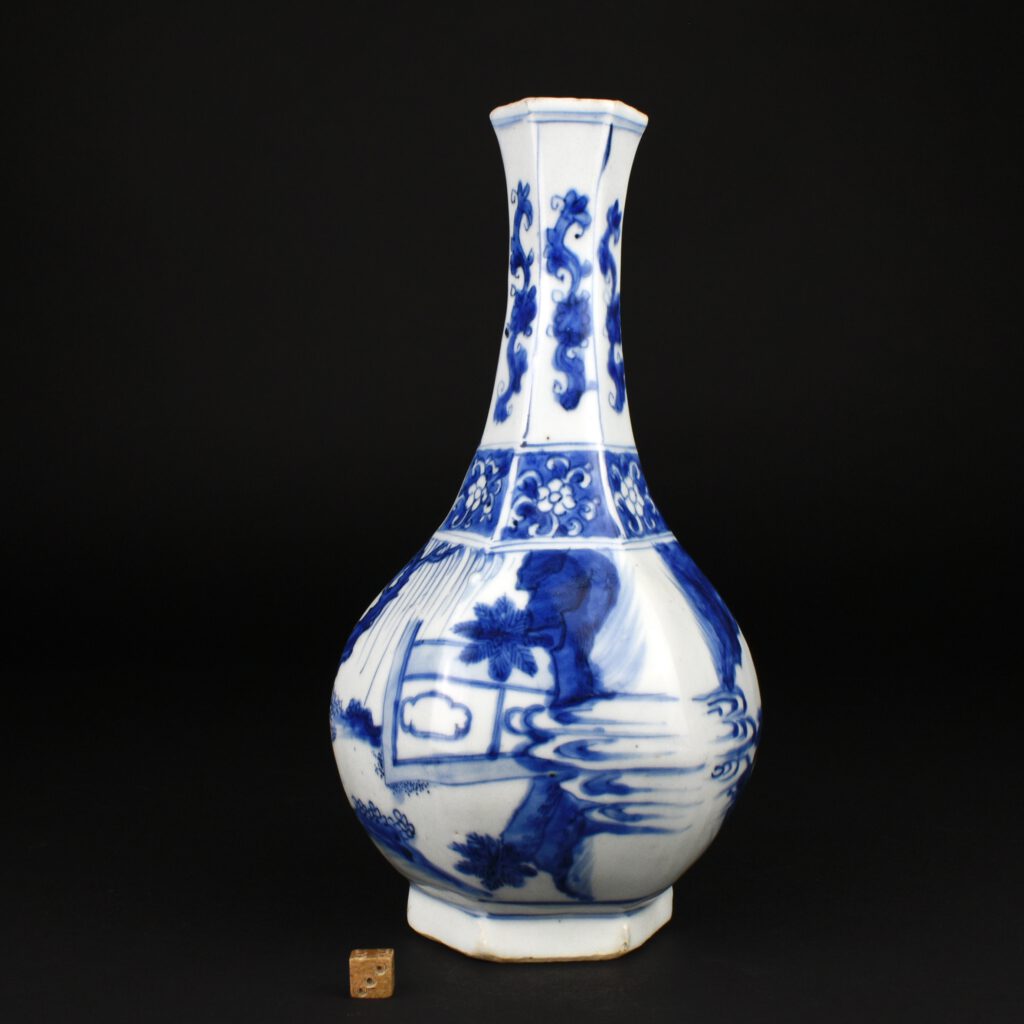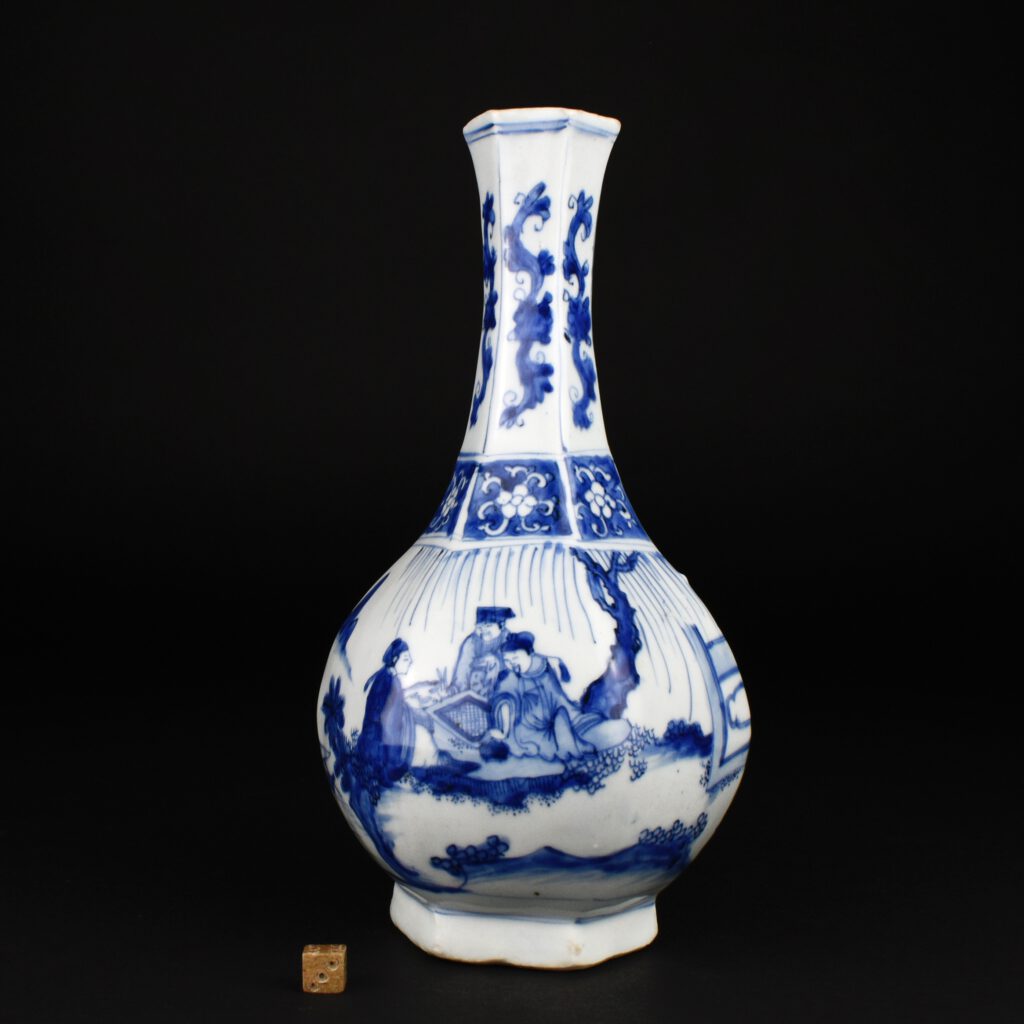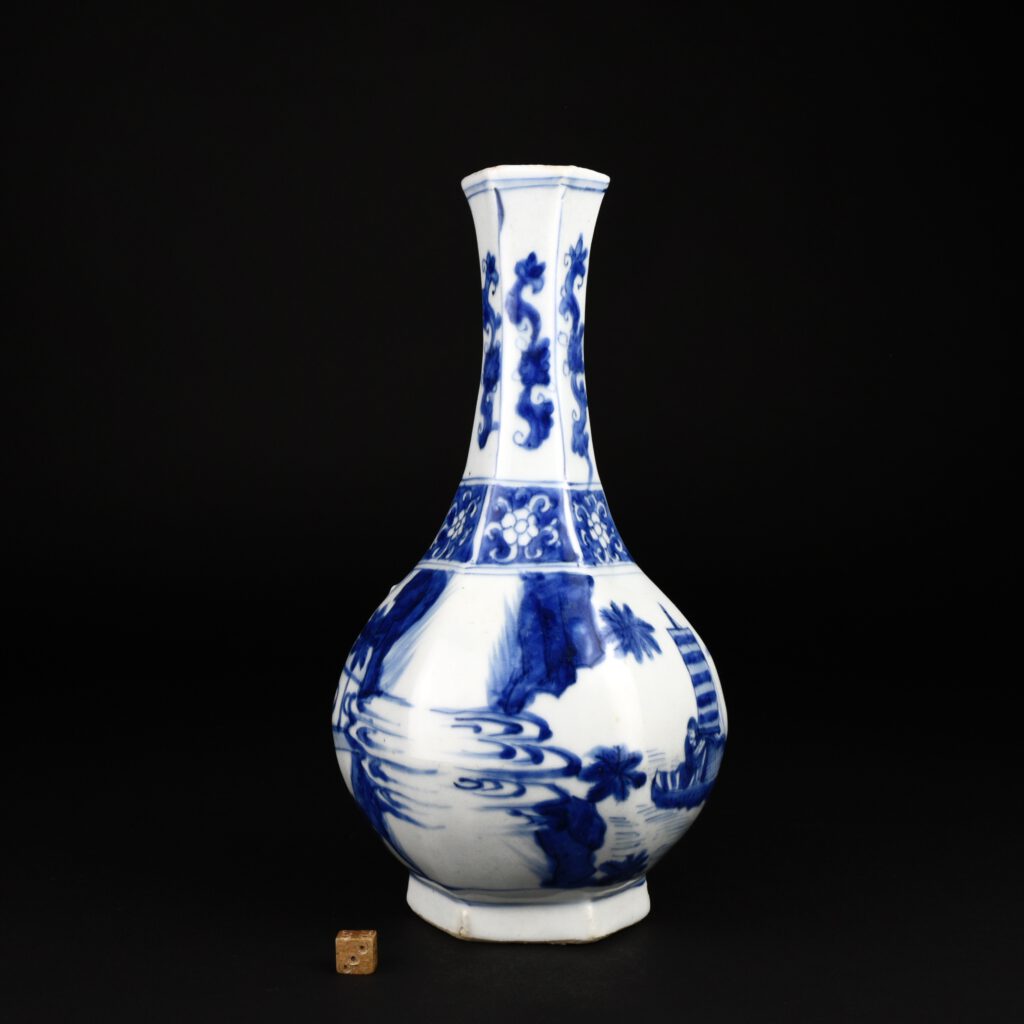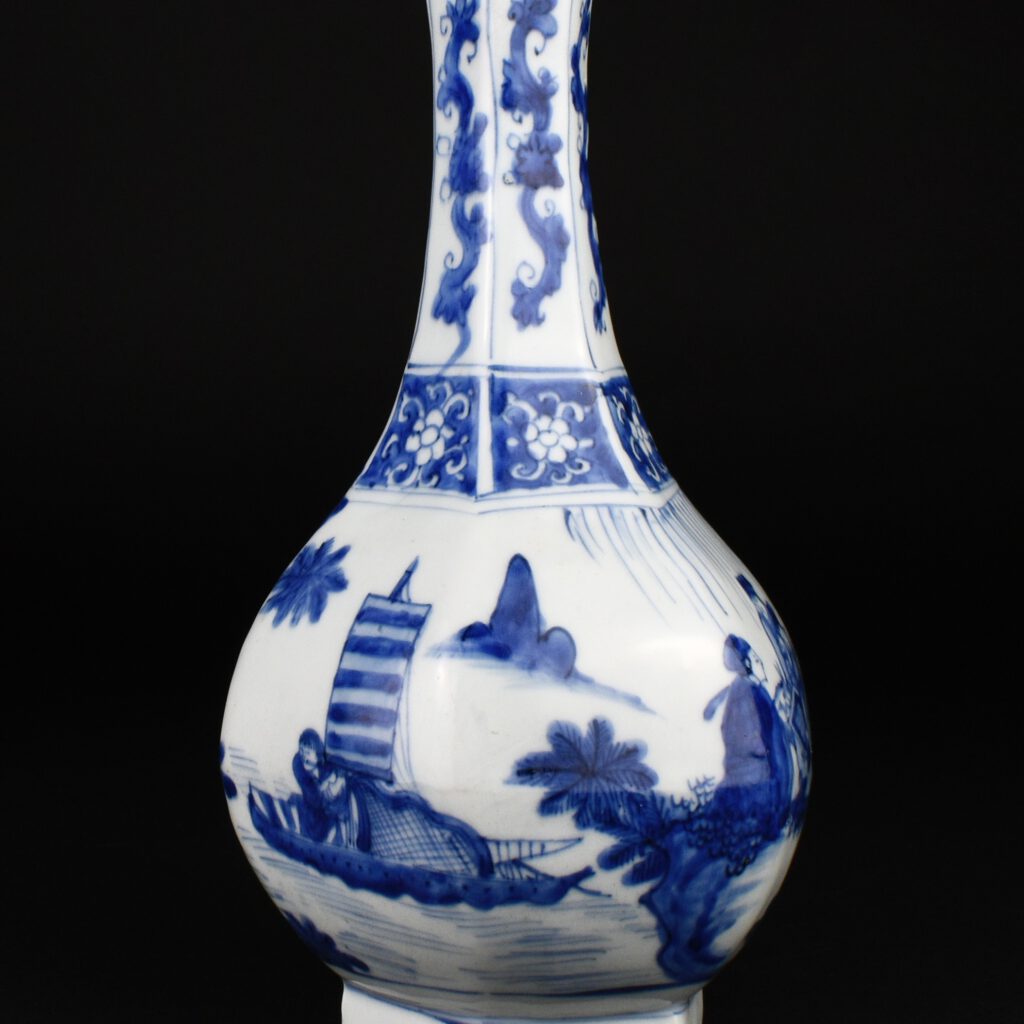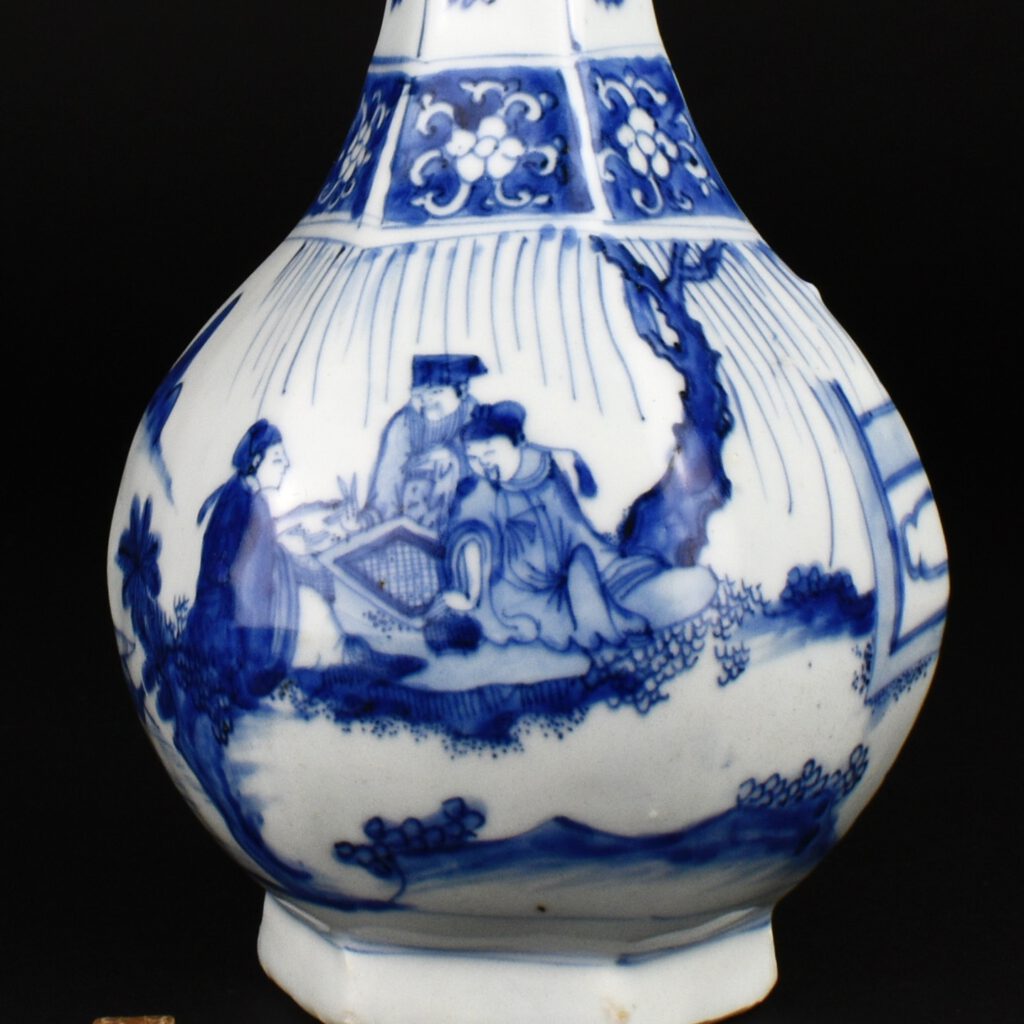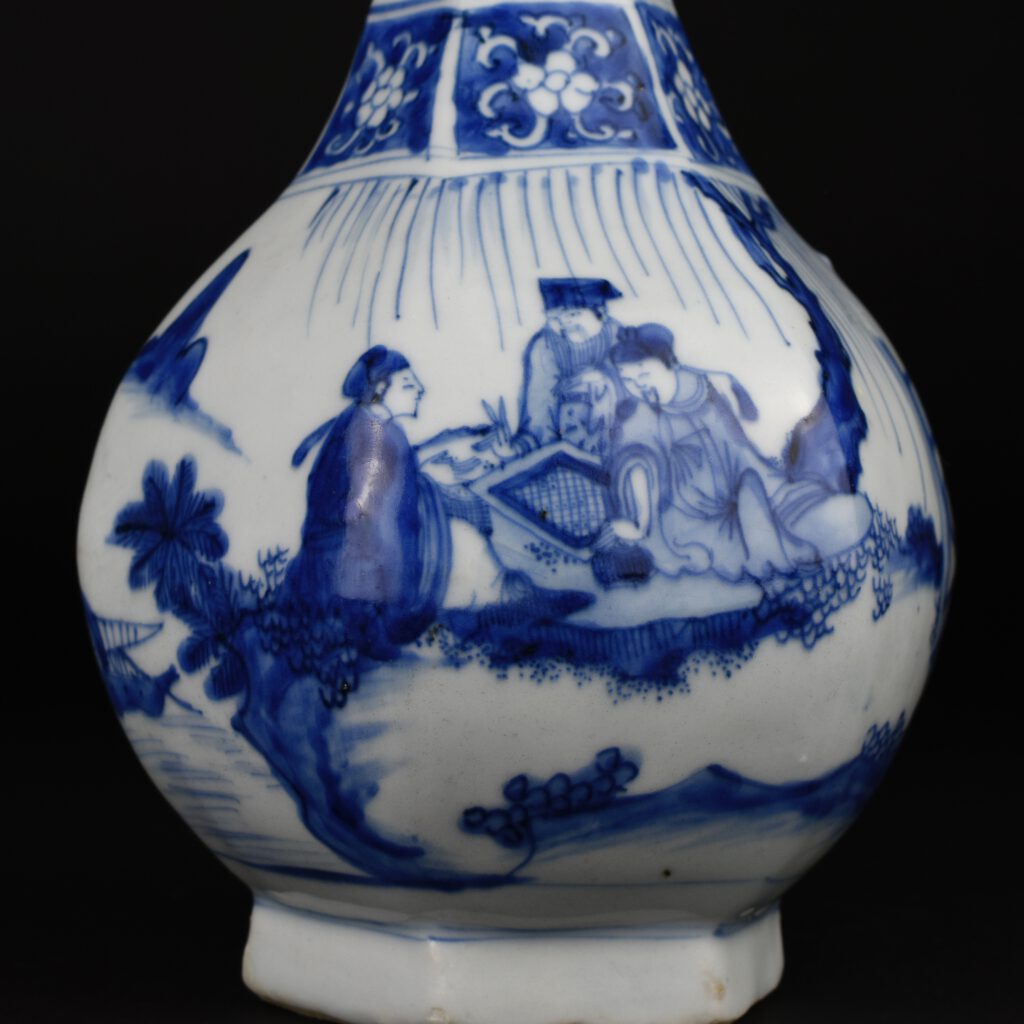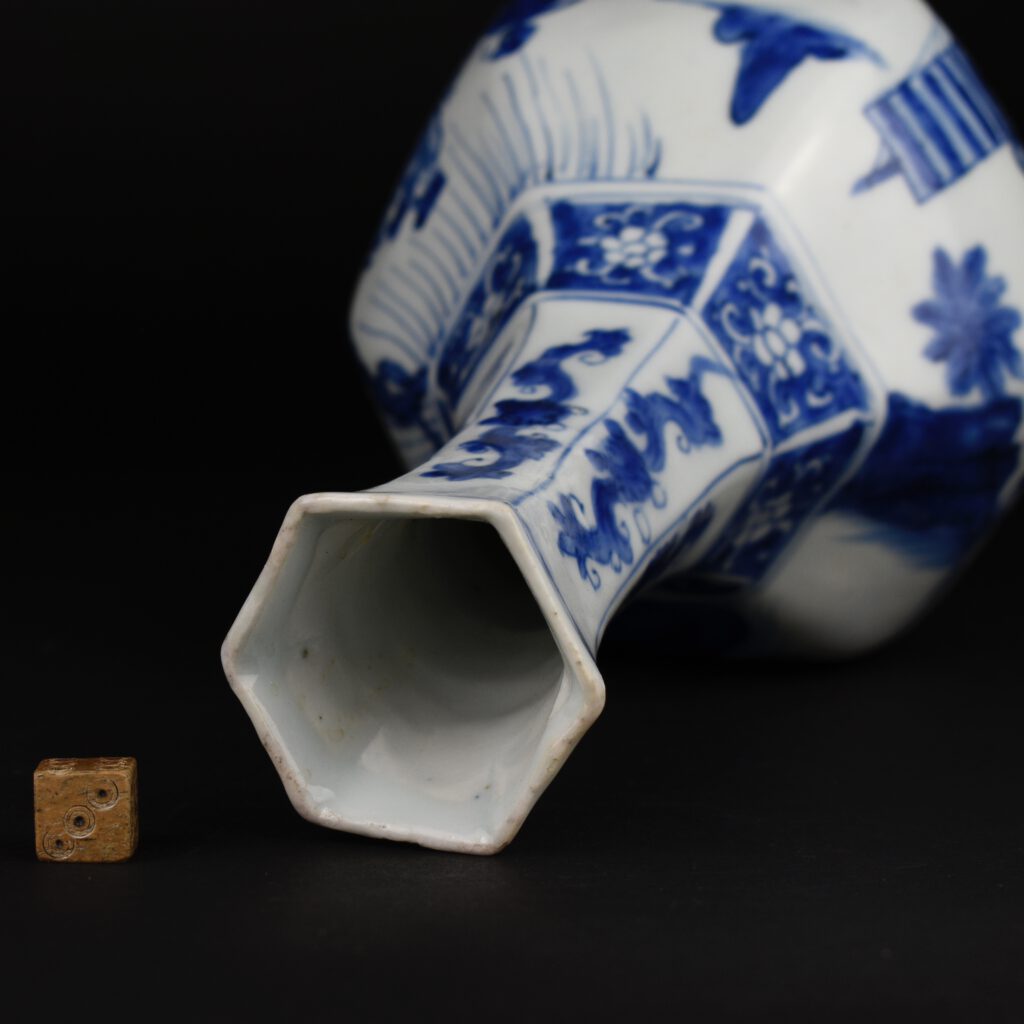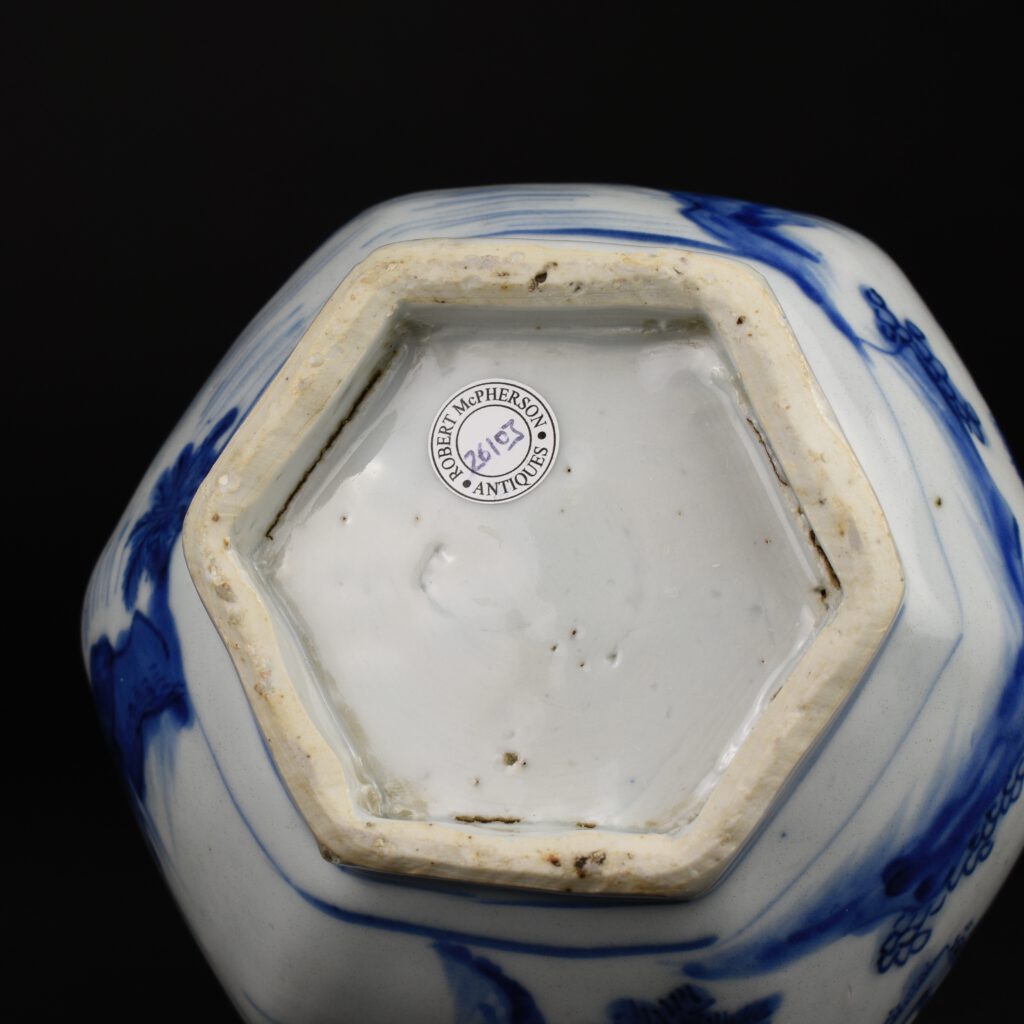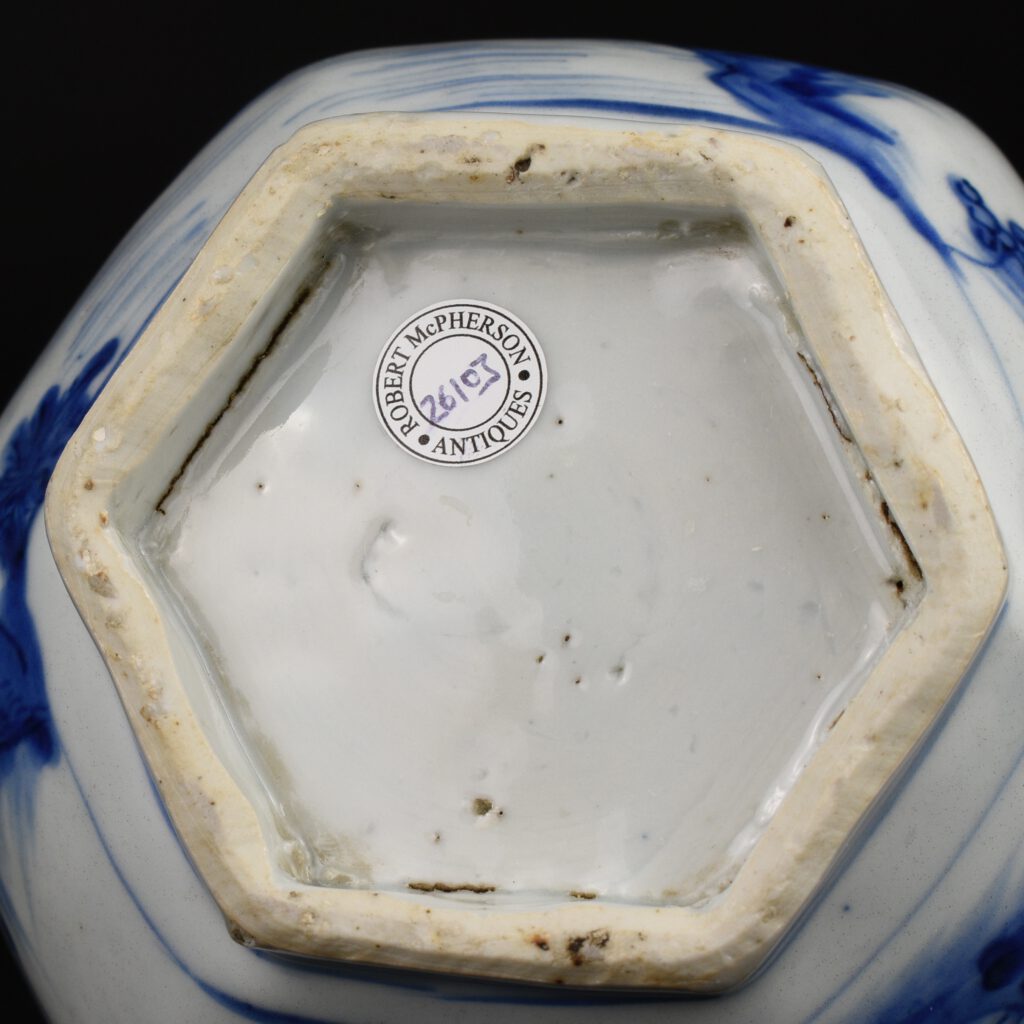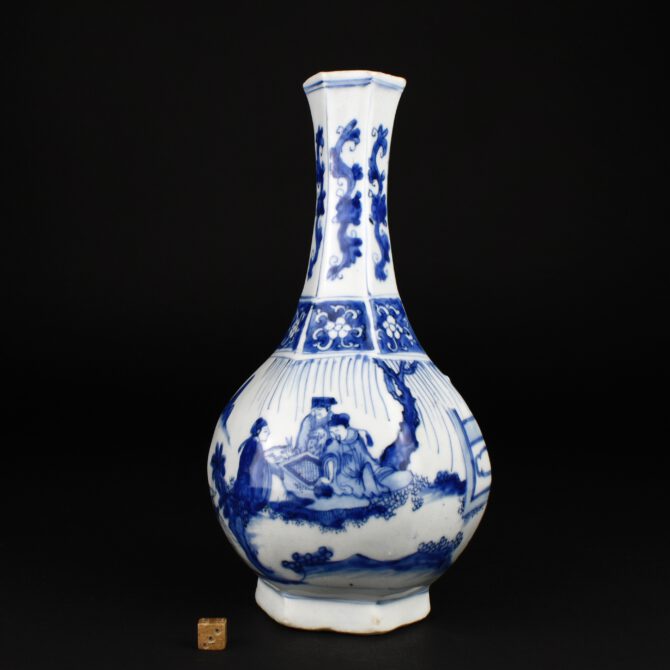
A Transitional Blue and White Porcelain Vase, Chongzhen Period
A Late Ming Blue and White Porcelain Vase, Chongzhen Period 1628 – 1644. This tall hexagonal Transition porcelain vase is decorated with vibrant tones of blue cobalt oxide. The main subject is a group of three scholars around a Weiqi board (see details below the photograph gallery), the figure behind the board is gesturing with his fingers, the figure to the right has his hand over the Weiqi counter box. They sit on a rock under a willow tree with an indication of the scene being set in a garden, there is part of a wall shown. To the left of the main scene is a simple shallow boat, the man on board appears to be playing the flute. The scene is not continuous, as is typical of Transitional blue and white porcelain rocks and clouds act as a break. A further Transitional element is the V shaped grass, though in the rendering of it here it is somewhat closer to U shaped grass. The tapering neck has a collar of simple open flowers and tendrils against a blue back ground, above that panels of stylised foliage with a flower in the center. This vase is one of a pair, I decided to split them as the scenes are different but at the time I’m sure they would have been seen as a pair. For more details see below the photograph gallery.
SOLD
- Condition
- In good condition. Three small glaze frits to the top filled. The vase is slight uneven in the potting.
- Size
- Height 27.2 cm (10 2/3 inches)
- Provenance
- N/A
- Stock number
- 26103
Information
A Transitional Blue and White Porcelain Vase, Chongzhen Period.
Robert McPherson Antiques - 26103 (shown with 26102)
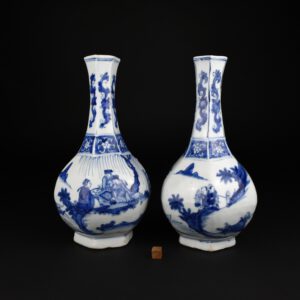
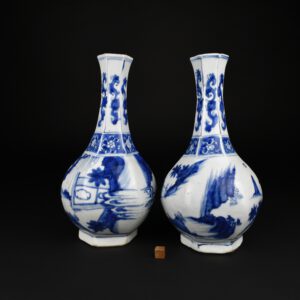
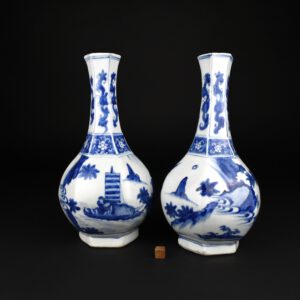
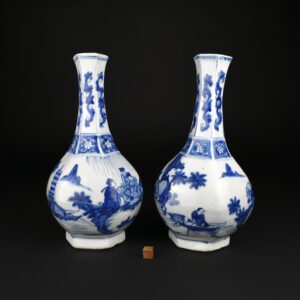
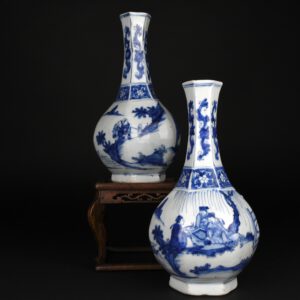
The Transitional Period c.1620 - 1680
The roots of this unsettled period starts during the later part of Wanli`s reign (1573-1620). At the begging of his reign China was doing very well, new crops from the Americas such as peanuts, maize and sweet potatoes increased food production, while simplified taxes helped the state run smoothly. But this was not due to Wanli`s enlightened reign, but to his Mother championing a man that was to become the Ming dynasties most able minister, Zhang Zhuzheng (1525—1583).
Wanli became resentful of Zhuzheng`s control but upon his death became withdrawn from court life. Between 1589 to 1615 he didn`t appear at imperial audiences, leaving a power vacuum that was filled by squabbling ministers. Mongols from the North raided as Japan invaded Korea. Wanli re-opened the silver mines and imposed new taxes but the money was lost due to corruption, as well as being frittered away by the indulgent Emperor himself . The next emperor of Ming China, Tianqi (1621-1627), was bought up in this self indulgent disorganised environment, at the very young age 15 his short reign started. He didn`t stand a chance. Tianqi made the mistake of entrusting eunuch Wei Zhongxian (1568-1627) who Anna Paludan in her excellent book “Chronicle of the Chinese Emperors” (Thames and Hudson, 1998) describes as “a gangster of the first order”.
Tianqi was deemed to have lost the Mandate of heaven by the Ming people. Tianqi`s younger brother, the last of the Ming Emperors, Chongzhen (1628-1644), was not able to save the situation. The systems of administration had broken down, corruption was rife and so when a sever famine broke out in 1628 nothing much could be done. Anna Paludan describes the tragic end to the great Ming Dynasty “The final drama was worthy of a Greek tragedy. The emperor called a last council in which `all were silent and many wept`, the imperial troops fled or surrendered, and the emperor, after helping his two sons escape in disguise, got drunk and rushed through the palace ordering the women to kill themselves. The empress and Tianqi`s widow committed suicide; the emperor hacked off the arm of one daughter before killing her sister and the concubines. At dawn he laid his dragon robe aside and dressed in purple and yellow, with one foot bare, climbed the hill behind the now silent palace and hanged himself on a locust tree”.
The Great Wall of China, started 2,000 years ago was built to protect China from the Northern barbarian hoards, it was often tested and sometimes failed. The Jin people invaded China, ruling the North between 1115 and 1234, it was their descendants the Manchus, Jurchens from south east Manchuria that took full advantage of the problems of the Ming dynasty. In 1636 they adopted a Chinese dynastic name, the `Great Qing` (Qing meaning pure). The first of the Qing emperors was Shunzhi (1644-1661) but for most of his reign his uncle ran the state. War raged on during this period and it wasn`t until the second Qing emperor Kangxi (1662-1722) that true peace was achieved. Kangxi was a wise and educated man, he became a highly successful emperor bringing China a long period of wealth and stability.
Pair of Transitional Blue and White Porcelain
Robert McPherson Antiques, Sold Archive. Stock number 21817.
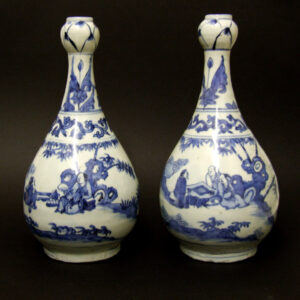
The Board Game Weiqi
Go known in Chinese as Weiqi and Go in Japan, is an ancient board game for two players that is noted for being rich in strategy despite its simple rules. The game is played by two players who alternately place black and white stones on the vacant intersections of a grid of 19×19 lines. The object of the game is to control (surround) a larger portion of the board than the opponent. Weiqi originated in ancient China more than 2,500 years ago, and although it is not known exactly when the game was invented, by the 3rd century BC it was already a popular pastime, as indicated by a reference to the game in the Analects of Confucius. Go reached the West through Japan, which is why it is commonly known by its Japanese name.
